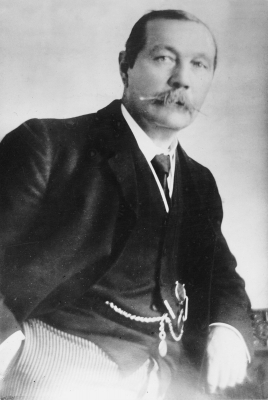What is the life story of Sir Arthur Conan Doyle?

Arthur Conan Doyle's "Sherlock Holmes" stories are considered to be milestones in detective fiction. However, it's not widely known that Doyle also helped investigate a real-life crime in the 20th Century and came to the rescue of a British Indian lawyer who was wrongfully convicted. In a new book, "The Mystery of the Parsee Lawyer: Arthur Conan Doyle, George Edalji and the case of the foreigner in the English village," which released on March 10, London-based author and historian Shrabani Basu digs up details about this long forgotten case.
According to the book, George Edalji, a barrister, wrote to Doyle in 1907 asking for his help. Edalji was jailed for allegedly committing a series of mysterious crimes in Staffordshire in England. But Edalji claimed to be innocent.
Doyle, who published "A Study in Scarlet", had become a household name in England and was often flooded with letters from fans asking him to help investigate crimes. Usually, Doyle did not take up any of these cases, but made an exception for Edalji. In a true Holmes like fashion, Doyle gathered all the clues and successfully proved that Edalji was wrongly convicted and framed on account of racism.
Rings a Bell?
Doyle was born in Edinburgh on May 22, 1859. He developed a love for storytelling from his mother Mary Doyle. Surprisingly, he chose to pursue medicine instead of arts-his family consisted of reputed artists. At med school, Doyle met his mentor, Professor Dr. Joseph Bell, whose keen powers of observation inspired him to create the famed fictional detective Sherlock Holmes.
Writing and cricket
Although a doctor by profession, Doyle's interests lay in writing and cricket. He frequently contributed to magazines and newspapers. One day, inspiration struck and he started writing a mystery novel, which would later become "A Study in Scarlet" marking the birth of the brilliant detective Sherlock Holmes.
Cricket too played an important role in Doyle's life. He joined a team of cricketers named Allahakbarries, which translates to Heaven Help US. The side was made up of literary luminaries such as Jerome K. Jerome, PG Wodehouse as well as the son of Alfred Lord Tennyson.
In fact Doyle named Sherlock Holmes after two county cricketers - Sherrinford and Shacklock. Sherlock's mysterious brother, Mycroft too is named after another cricketer and so is his archenemy. Moriarty.
A remarkable legacy
Doyle passed away on July 7, 1930 at the age of 71. But his legacy is unparalled. The genre of detective fiction grew leaps and bounds because of his contribution.
WHAT'S NEW?
- Sherlock Holmes has been adapted to the screen multiple times. But the latest eight-part series by Netflix, gives Sherlock a supernatural twist. "The Irregulars", set to release on March 26 follows a group of teenagers who and embark on dark adventures. They are manipulated into solving crimes by a sinister Dr. Watson.
- In October 2020, the estate of Arthur Conan Doyle filed a lawsuit against the creators of the film "Enola Holmes" for portraying Sherlock's softer side. The estate claimed that the film about Sherlock's sister infringed the copyright by depicting a warmer and emotional Sherlock. The lawsuit was subsequently dismissed.
OH REALLY?
- The other side of the coin: Although Doyle gained recognition writing tales of the analytical and rational detective, he became obsessed with supernatural phenomena in the latter part of his life. This was a result of the untimely deaths of his children and brother in World War I.
- Doyle was a first-class cricketer and is famous for taking the wicket of the legendary W.B. Grace. But did you know that Doyle even played football? He played as a goalkeeper for Portsmouth FC under the pseudonym AC Smith
- Doyle brought back dinosaurs! His book, "The Lost World" was the inspiration behind films such as "King Kong" and "Jurassic Park."
Picture Credit : Google

